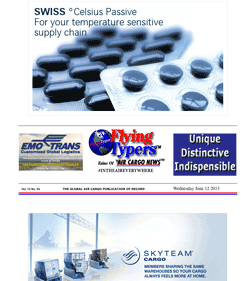
 hen
it comes to dangerous goods
(DG) shipping, everything is
in compliance—or so it
seems. hen
it comes to dangerous goods
(DG) shipping, everything is
in compliance—or so it
seems.
Forwarders and (more to the
point) their industry associations
tend to complain about lack
of recognition on the side of
airlines.
And indeed, the relationship
between forwarders and airliners
is in dire need of being redefined.
Shippers
complain about why they cannot
directly deal with the airlines
and why airlines are seemingly
unable to meet the specific
needs of shippers.
As
always, there are three sides
to this story, and all stakeholders
involved have more or less reason
to complain.
However,
when it comes to the shipping
of Dangerous Goods by Air, more
often than not, forwarders don’t
do what they’re paid to
do.
Airlines,
conversely, are sometimes unable
to admit when they are in error,
and shippers do business “like
we have always done it.”

All
Dangerous Goods shipped by air
by means of civil air transport
must conform to the “ICAO
Technical Instructions for the
Safe Transport of Dangerous
Goods by Air” in their
most recent edition.
In
most cases the more restrictive
“Dangerous Goods Regulations”
of the International Air Transport
Association are applied, since
these are an industry standard
and required for all DG shipped
by an IATA member airline or
associated airline.
Both
the ICAO TI and the IATA DGR
recognize so-called “state
and operator variations,”
which means that both states
and airlines may impose further
requirements on each DG consignment.
Typical
additional requirements are
the indication of emergency
contact numbers, embargoing
certain commodities from carriage,
or requiring additional packaging
measures, such as an Overpack.

The
issue at hand is that the shipper
would need to know both the
airline transporting the cargo
and its exact routing.
That
is far away from being as trivial
as it seems, since most shippers
and forwarders tend to use the
least expensive option.
In
other words, the cheapest offer
will make it.
This
isn’t helped by the fact
that state and operator variations
are subject to frequent changes,
updated with each addendum or
corrigendum of the IATA DGR,
and that shippers have a hard
time incorporating such additional
requirements into their shipment
preparation procedures.
Shippers
tend to focus on their own business,
and rightly so.
They
do not necessarily need to know
which airlines have merged (IB/BA
and KL/AF/MP come to mind) or
cooperate in some way.
That’s
what they pay their forwarders
for, but a cargo consignment
booked on AF may in fact be
carried by MP on a different
routing than anticipated by
the shipper, which means that
first, the airline must inform
the forwarders they work with
about any such particular requirement,
and second, the forwarder must
communicate such requirement
to the shipper prior to undertaking
preparation of the shipment.
Rejection
statistics show that there are
considerable shortcomings in
practice.

Let’s
assume that one wants to ship
120 Liters of a medium danger
paint (packing group II, for
those familiar with the term)
from Europe to, say, Hong Kong.
The
IATA DGR will permit the shipper
to pack a maximum net quantity
of 5 liters per combination
packaging (consisting of inner
and outer packaging components),
where such shipment is to be
transported aboard a passenger
aircraft, or a maximum of 60
liters either per single packaging
(such as a steel drum or plastic
jerrican) or combination packaging
at the shipper’s choice,
where the consignment is intended
to go on an all-cargo aircraft.
That’s
a basic requirement of the regulations,
and shippers typically have
no issues with that.
However,
if the forwarder has earmarked
Cathay Pacific (CX) for carriage,
they better inform the shipper
about CX’s requirement
to have all single packages
overpacked (such Overpacks are
intended to avoid costly damages
and spills, particularly on
smaller aircraft not using ULDs).
More
often than not, shippers are
not provided with the original
“DG acceptance check sheet”
of the airline, and it seems
common practice for shippers
to foot rejection fees caused
by forwarder’s shortcomings.
The
aforementioned “DG acceptance
check sheet” is intended
to ensure the shipment is in
full compliance with all applicable
regulatory requirements.
Subparagraph
1.3.1 of the IATA DGR 54 require
that “A shipper must fully
comply with these Regulations
(…).
“In
addition, shippers must comply
with any applicable regulations
set forth by the states of origin,
transit, and destination”—and
sometimes also consider the
requirements of states which
are just overflown.
That’s
a bold requirement, and one
shippers usually can’t
comply with without proper guidance
from their forwarders.

Publications
such as the IATA TACT Rules—available
only on a subscription basis—help
to establish such additional
requirements not necessarily
limited to Dangerous Goods;
for example, weaponry of a non-dangerous
nature often requires transit
permits.
There
seems to be precious little
communication between shippers
and forwarders about these issues.
Most
shippers admit in DG training
that they do not know on which
airline their shipment will
fly, and more often than not
the most neglected personnel
group in the transport chain—the
DG packer—claims to have
no knowledge even about the
transport mode for the shipments
he is tasked to prepare.
The
latter, however, is a source
for a potential disaster waiting
to happen, since the air mode
has certain packaging requirements
that neither road, nor maritime,
nor rail transport has.
One
must keep in mind that only
the outside of a package can
and must be inspected during
a DG acceptance check. Where
packages are overpacked, the
DG check sheet can and must
only consider the requirements
applicable to such Overpack,
not to the packages contained
therein.
Opening
of packages that do not exhibit
signs of apparent non-compliance
or spill is usually limited
to DG Inspectors from regulatory
authorities and customs officers,
and since most DG packages cannot
be resealed in a compliant way,
that is hardly ever done.

Nevertheless,
DG training for shippers also
shows that shippers are prone
to certain misperceptions in
regard to the packaging materials
being used.
A
common error is to assume that
because the outer packaging
is of the UN specification type
and the particular packaging
is permitted by means of the
applicable packing instruction
of the IATA DGR, it is in compliance.
Nothing
could be further from the truth.
A package is always a packaging
system, consisting of elements
such as inner, outer, and intermediate
packagings, seals, fittings,
tape, cushioning material, absorbent
material, and the like.
What
is permitted—and what
is not permitted—must
be determined in accordance
with the packaging performance
certificate and the closure
instructions provided by the
packaging’s manufacturer.
A
considerable number of the students
in DG training qualifying for
shipping DG admit that they
have never seen such documentation,
least of all have they ever
considered “conditions
normal in air transport”
prior to shipping.
Since
there is no definition for normal
conditions of carriage worldwide,
the user is obliged to specify
a packaging design that meets
the requirements of his particular
application, since only he knows
whether the packaging will be
going on a long sea voyage into
hot and moist tropical climates,
or by rail into cold Siberia.

The
user should know that during
shipment by air, there will
be a drop in air pressure.
Thus,
even in the case where the approval
does not require an inner receptacle
in a combination packaging,
the user must have provided
evidence that a test for 75
kPa or 95 kPa respectively has
been successfully passed.
As
clear as the verbiage of the
BAM’s regulatory guidance
may be, regrettably it is not
often taken into consideration
when it comes to the packaging
of Dangerous Goods.
It
may be noteworthy that especially
large sized organizations with
clearly defined reporting requirements
and a multitude of DG-trained
staff are subject to certain
shortcomings.

Now
that we’ve laid some blame
on both shippers and forwarders
it should be noted that airlines
also have some homework to do.
In
clear words, an IATA member
carrier should not uphold a
rejection where regulatory guidance
from either IATA or a competent
national authority indicates
that the shipper is not in error
(and where the shipment in question
does not contradict an applicable
operator or state variation).
Such
practices are certainly not
the norm, but they happen far
too often to put shippers at
ease.
In
general—probably because
of liability issues and broader
experience—ground handling
service providers acting on
behalf of airlines often seem
to do a better job than the
airlines themselves, maybe because
of their business relationships
with all stakeholders in the
transport chain.
A
considerable number of shipments
are stopped in transit because
of apparent shortcomings, which
underlines that airlines are
not entirely free from such
shortcomings. Furthermore, airline
cargo and passenger sales and
reservation staff are not always
DG trained as required, thus
causing commodities which may
or may not contain DG being
unidentified in the first line:
When
commodities such as “spare
parts,” “pharmaceuticals,”
or “consumer electronics”
are offered for transport, it’s
the carrier’s and forwarders
obligation to establish the
exact nature of the goods beforehand.
The
air transport industry is changing
and adapting to the requirements
of volatile markets and cyclical
downturns by various means,
and rightly so; however, it
seems that the stakeholders
still do not communicate enough.
Just
as a by note, it should be said
that whatever homework airlines
may have to do, DG check fees
are certainly not a source of
ancillary revenue.
When
all related costs are factored
in, DG check fees may cover
the cost of the product, but
not much more.
Last
but not least, IATA for one
may want to work on the language
quality of their foreign editions.
Although
“not legally binding,”
more often than not these are
the only regulatory source shippers
and forwarders have at their
disposal for the shipping of
DG.
Jens/Flossie
|






 hen
it comes to dangerous goods
(DG) shipping, everything is
in compliance—or so it
seems.
hen
it comes to dangerous goods
(DG) shipping, everything is
in compliance—or so it
seems.
 hile
attending the sessions at EMO
Trans Annual Meeting in Lisbon
this year, we were struck by
the universal benefit of sharing
both ideas and logic, not only
by EMO team members, but also
various presenters at the four-day
event.
hile
attending the sessions at EMO
Trans Annual Meeting in Lisbon
this year, we were struck by
the universal benefit of sharing
both ideas and logic, not only
by EMO team members, but also
various presenters at the four-day
event.

